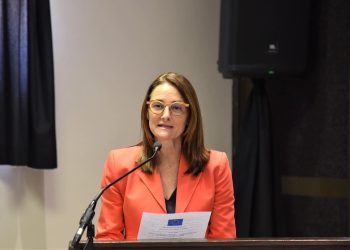
The Government Institutions Pension Fund (GIPF) has demonstrated impressive financial health for the fiscal year ending 31 March 2024.
Total assets rose from N$151 billion to approximately N$168 billion, reflecting an 11% year-on-year growth.
Assets under management now constitutes 71.3% of Namibia’s GDP compared to a global average of 54%. This increase highlights the Fund’s resilience, particularly in a climate that has witnessed market volatility.
“During the period under review, the global and domestic economic landscape faced challenges due to ongoing geopolitical tensions, including the war in Ukraine and instability in the Middle East. Despite these difficulties, GIPF paid out N$6.9 billion in claims, continuing a five-year upward trend in payouts, reaffirming the Fund’s commitment to fulfilling its obligations to members, even in challenging economic conditions,†said Leevi Tshoopara: Acting GM Investments at the GIPF.
Commitment to Sustainability
Sustainability remains at the core of GIPF’s operations. As a defined benefit fund (which pays guaranteed retirement income based on member salary and years of service), GIPF guarantees retirement benefits, ensuring financial security for its members regardless of market fluctuations.
“GIPF’s sustainability is bolstered by the Fund’s ability to generate increasing net returns from investments, supplemented by contributions from its 99,722 members and 44 participating employers. This enables the Fund to continue to deliver income security for retirement, disability, and other auxiliary benefits while promoting ethical governance and financial transparency,†he said.
Domestic Investments
Nearly half (48%) of GIPF’s total assets are invested in Namibia, in compliance with the domestic asset requirement directives premised on creating value in the local economy. A notable achievement during the reporting period was the approval of a renewable energy Diaz Wind Farm project that would generate 44 Megawatts, supporting Namibia’s transition to cleaner energy sources.
“This initiative reflects GIPF’s dedication to sustainable investments that benefit the broader community. The Fund has now invested N$1.4 billion in renewable energy projects to date contributing 163 Megawatts to Namibia’s energy generation capacity with a further N$2.7 billion committed to renewable energy projects,†Tshoopara said.
Expanding Access and Service Delivery
GIPF has made significant strides in enhancing service delivery for its members across Namibia’s 14 regions. The opening of new regional offices ensures that members, particularly in remote areas, can access essential services more easily. Currently, GIPF operates 11 regional offices, strategically located in cities such as Windhoek, Rundu, Katima Mulilo, Outapi, Eenhana, Oshakati, Ondangwa, Otjiwarongo, Swakopmund, Gobabis, and Keetmanshoop, along with satellite offices in Grootfontein, Nkurenkuru, Opuwo, and Mariental.
“This nationwide presence reinforces the Fund’s commitment to a member-centric service, aiming to bring services closer to members with minimal turnaround time and maximum value. The Fund’s new strategy includes a comprehensive digital transformation, implemented in phases to ensure a smooth transition both internally and externally. A key initiative underway is the rollout of an integrated pension fund
administration system, which will streamline operations, reduce costs, and enhance service efficiency, leading to faster response times for members,†he said.
Additionally, the Fund introduced a mobile verification technology, enabling members to confirm their identities (proof of life) through collaboration with various constituency council offices via handheld devices or through self-service on mobile devices.
“This innovation is especially beneficial for those in remote areas, where visiting the Fund’s offices can be time-consuming and costly,†Tshoopara said.
Key Achievements During the Period Under Review
GIPF continues to actively support national development priorities and programmes, channelling its investments and resources into key areas in the Namibian economy such as social infrastructure, and regional development. In this regard, GIPF plays a crucial role in advancing the country’s economic growth, poverty reduction, social development, and regional balance, contributing to the overall development and well-being of the Namibian people.
In the period under review, Fund assets grew to N$168 billion, maintaining a strong funding level of 115.51%, during the period, based on the 18-month actuarial interim review which consequently improved to 119.69% as of 31 March 2024, positioning GIPF among the top-performing pension funds not just in Africa but globally.
The Fund committed over N$3.3 billion to various sectors, including housing, agriculture, and renewable energy, with N$438 million specifically invested in agribusinesses.
GIPF delivered over 7,840 affordable homes and serviced 5,884 plots, contributing to national housing objectives. The Fund is currently engaging stakeholders on its pension-backed home loan (PBHL) scheme, a key, short-term value initiative designed to enable members to access a portion of their pension benefits for property acquisition.
“This scheme aims to provide greater financial flexibility and promote homeownership opportunities. This not only addresses immediate housing needs but also contributes to the broader economic development of Namibia,†he said.
During the year, GIPF generated N$18 billion in net investment income, with an overall investment return of 13.2%, surpassing the benchmark of 11.7%. The Fund’s assets include a diversified portfolio across various sectors, asset classes and geographical locations, ensuring risk management and maximising returns.
Addressing Challenges
Despite its successes, GIPF faced challenges, particularly the geographic distribution of its members and the increasing number of pensioners relative to active members. These factors place additional pressure on the Fund, necessitating ongoing investment in digital tools and service delivery innovations.











